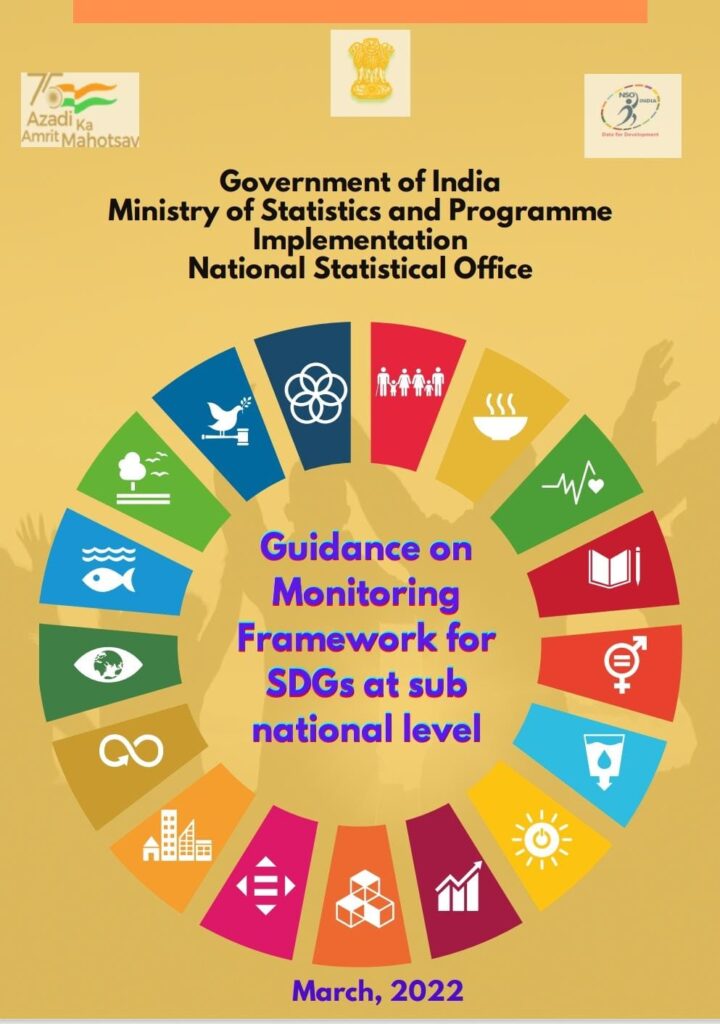TRACKING IMPLEMENTATION OF THE SDGs LOCALIZATION: SELECTED COMPARATIVE CASE STUDIES OF INDIAN DISTRICTS
Shravani Thota, Muskan Jaiswal, Rishabh Dev Bharadwaj, Avika Kamboj, Rajlakshmi Anand
ABSTRACT
When the world is counting down the time to fulfill the 17 SDGs and associated 169 targets set for the Agenda @2030, countries adopt the tailored solution of SDGs localization for the faster addressal of the global risks, especially with popular and enigmatic narratives like ‘Sabka Saath, Sabka Vikaas, Sabka Vishwaas with Sabka Prayaas’ in India. Thus, this paper undertakes the four selected comparative case studies of Indian states (districts) to examine the country’s progress and loopholes in implementing SDG localization, namely, i.) North West (Delhi), ii.) Hyderabad (Telangana), iii.) Kolkata (West Bengal), and iv.) Noida (Uttar Pradesh). The paper employs a mixed methodology of qualitative and quantitative analysis of the synchronized data, i.e., National Indicator Framework (NIF) and District Indicator Framework (DIF) released by the nodal agencies responsible for the SDGs tracking in the respective locale in alignment with the Global Indicator Framework (GIF).
Keywords: SDGs Localization; Agenda 2030; India; Tracking, Global Indicator Framework (GIF), National Indicator Framework (NIF), District Indicator Framework (DIF); Nodal Agency, Delhi, Hyderabad, Kolkata, Noida.
INTRODUCTION
The Sustainable Development Goals (SDGs) represent a comprehensive and universal framework designed to address pressing global challenges while advancing sustainable development across economic, social, and environmental dimensions. Adopted in 2015 as part of the United Nations (UN) 2030 Agenda for Sustainable Development, the SDGs build upon the achievements and lessons of the Millennium Development Goals (MDGs). Encompassing 17 interrelated goals and 169 specific targets, the SDGs serve as a strategic blueprint for fostering inclusive economic growth, reducing inequalities, safeguarding environmental sustainability, and promoting global peace and prosperity.
The SDGs originated from global deliberations on sustainable development, notably at the Rio+20 Conference on Sustainable Development (2012), which emphasized the need for a comprehensive global agenda to address sustainability and inequality. These discussions led to the establishment of the Open Working Group (OWG), whose extensive consultations with governments, civil society, and stakeholders shaped the final set of goals. The SDGs were unanimously adopted by 193 UN member states at the 2015 UN Sustainable Development Summit and were officially implemented on January 1, 2016.
What distinguishes the SDGs is their universality and interconnectedness, applying to all countries and integrating the economic, social, and environmental dimensions of development. They emphasize inclusivity, ensuring that progress benefits all people, and adhere to the principle of “leaving no one behind.” By setting a collective vision for sustainable development, the SDGs aim to address global challenges holistically and achieve transformative change by 2030.
SIGNIFICANCE OF SDG LOCALIZATION IN THE INDIAN LANDSCAPE
The localization of Sustainable Development Goals (SDGs) is essential for ensuring the goals are translated into actionable policies that address the unique challenges of specific regions and communities. This process ensures that global aspirations are customized to suit local contexts, enabling more effective implementation and meaningful outcomes. As a signatory to the 2030 Agenda for Sustainable Development and the most populous country in the world, India has been actively localizing these goals to align them with its diverse socio-economic and geographical landscape. Home to 17% of the global population, India’s participation is vital for the success of the SDG agenda. The principle of “Leave No One Behind” (LNOB) of Agenda 2030 is reflected in the Government of India’s “Sabka Saath, Sabka Vikas, Sabka Vishwas, Sabka Prayas” policy. This paper explores India’s institutional framework, integration of SDGs into developmental plans, monitoring mechanisms, challenges, and innovative practices to achieve effective localization. The following are the highlights discussing the execution of SDGs in the Indian locale.
-
) Institutionalizing SDGs framework – India has established a multi-tiered institutional framework to localize the SDGs. At the national level, the NITI Aayog is the nodal agency coordinating and monitoring SDG implementation. It has developed the SDG India Index, a robust tool for assessing and ranking states based on their progress towards achieving the goals (NITI Aayog, 2023). The states and Union Territories (UTs) are pivotal in tailoring SDG strategies to their unique contexts. Many states have established dedicated SDG cells to oversee implementation and monitoring (NITI Aayog, 2022). At the grassroots level, district administrations and Panchayati Raj Institutions (PRIs) integrate SDGs into local planning, addressing specific challenges such as poverty alleviation, healthcare access, and educational outcomes. India’s federal structure necessitates localization as subjects like public health fall under the State List and education under the Concurrent List, as per the Seventh Schedule of the Constitution. This division of responsibilities highlights the importance of aligning global SDG targets with the developmental priorities of states and local bodies.
-
) Integration with Development Plans – India’s localization efforts are characterized by the alignment of national development programs with SDG targets. For instance, initiatives such as the Pradhan Mantri Jan Dhan Yojana and the Mahatma Gandhi National Rural Employment Guarantee Act (MGNREGA) contribute directly to achieving SDG 1 (No Poverty). Similarly, programs like the Samagra Shiksha Abhiyan and Digital India enhance educational outcomes, addressing SDG 4 (Quality Education). Climate action, encapsulated in SDG 13, is supported by the National Action Plan on Climate Change (NAPCC) and state-specific climate action plans (Press Information Bureau [PIB], 2024). Additionally, India’s active participation in global initiatives such as the International Solar Alliance (ISA) and the Coalition for Disaster Resilient Infrastructure (CDRI) underscores its commitment to achieving SDG targets.
-
) Urban Challenges and Local Governance – India’s urban centers face immense pressure due to population growth and unplanned urbanization. Localizing SDG 11 (Sustainable Cities and Communities) ensures that urban challenges such as housing, transportation, and waste management are addressed in a tailored manner. For instance, Kushwaha et al. (2023) emphasize the importance of disaggregating data for Indian cities to better align planning priorities with SDG targets.
-
) Community Development in Rural Areas – Localizing SDGs in rural India ensures community-driven development. For example, empowering rural populations to address poverty (SDG 1), hunger (SDG 2), and water and sanitation (SDG 6) helps bridge the urban-rural divide. Rath and Panda (2024) highlight the transformative potential of SDG localization in rural development.
-
) Innovative approaches and initiatives adopted by the States – Kerala’s decentralized planning model, exemplified by the People’s Plan Campaign, empowers local governments to integrate SDGs into development plans (NITI Aayog, 2022); Chhattisgarh’s utilization of PRIs to drive community-centric development aligned with SDGs; Maharashtra’s deployment of Geographic Information System (GIS) mapping to enhance the efficiency of SDG monitoring. States like Gujarat have led the way in integrating SDGs into policy frameworks, particularly in areas like health and education. This demonstrates how localized efforts can foster innovation in achieving development outcomes (Dighe and Majumder, 2021).
-
) Localized planning processes and collaborative efforts – Localization also involves integrating SDGs into local planning processes, such as the PRIs and the urban local bodies which are instrumental in promoting community ownership of SDG initiatives, i.e., Gram Panchayat Development Plans (GPDPs), which ensures grassroots participation in development initiatives (Chakradhar and Pisupati, 2018). The localization of SDGs in India involves collaboration across various sectors. Government bodies, including central ministries, state governments, and local authorities, ensure policy coherence and effective implementation. The private sector, through Corporate Social Responsibility (CSR) initiatives and innovative financing mechanisms such as green bonds, significantly contributes to SDG financing. Civil society organizations (CSOs) bridge the gap between policy and grassroots implementation, ensuring that development reaches the most vulnerable populations. Local communities, particularly PRIs and urban local bodies, are instrumental in promoting community ownership of SDG initiatives.
-
) Role of technology – Technological advancements facilitate SDG localization in India. Big data and artificial intelligence (AI) enable real-time monitoring and predictive analysis of development trends. Mobile applications and digital platforms promote citizen engagement and feedback, fostering transparency and accountability. These tools also enhance stakeholder knowledge sharing, capacity building, and resource mobilization (PIB, 2024).
-
) Monitoring and Data Collection – Monitoring plays a critical role in ensuring the effectiveness of SDG localization. The SDG India Index, developed by NITI Aayog, evaluates state and UT performance based on indicators aligned with the National Indicator Framework (NITI Aayog, 2023). This fosters competitive and cooperative federalism. Additionally, many states have launched real-time dashboards to monitor progress at local levels, enhancing transparency and accountability (NITI Aayog, 2022). Despite these advancements, data gaps at district and village levels pose significant challenges to effective monitoring and evaluation.
-
Obstacles in terms of realizing SDGs in India – Despite commendable progress, several challenges hinder the localization of SDGs in India. i.) Data Gaps: Inconsistent and insufficient data at district and village levels limit effective monitoring and evaluation. ii.) Resource Constraints: Financial and human resource limitations at the grassroots level impede program implementation. iii.) Coordination Issues: Overlapping responsibilities at various government levels leads to inefficiencies. iv.) Awareness Levels: Limited understanding of SDGs among local communities restricts their active participation (NITI Aayog, 2022).
In conclusion, India’s approach to SDG localization demonstrates a commitment to aligning global goals with local contexts and realities. Through coordinated efforts, technological integration, and pronounced community engagement, India strives to achieve the Sustainable Development Goals set as the Agenda @2030. Thus, this localization ensures that the SDGs are not just aspirational but actionable and impactful. However, certain challenges remain crucial to address to ensure that ongoing innovations and collaborative efforts provide a strong foundation for fostering sustainable and inclusive development across the country. Enhance Awareness: Community-level campaigns should increase understanding of SDGs and their relevance. Strengthen Capacity Building: Training for local officials and stakeholders is essential for effective implementation and monitoring. Promote Equity: Targeted interventions must focus on marginalized and vulnerable groups to ensure inclusivity. Foster Multi-Stakeholder Partnerships: Collaboration among government, private sector, academia, and civil society is crucial. Develop Robust Monitoring Frameworks: Addressing data gaps and improving grassroots data collection will enhance accountability (NITI Aayog, 2022).
REFERENCES
– Kushwaha, A., & et al. (2023). Disaggregating data for urban SDG implementation in Indian cities. Journal of Urban Development and Policy Research, 15(3), 210–225.
– Rath, S., & Panda, B. (2024). Bridging the urban-rural divide through SDG localization in India. Rural Development Perspectives, 8(1), 45–62.
– Dighe, P., & Majumder, R. (2021). Innovative state initiatives for SDG integration: The case of Gujarat. Development Strategies and Policy Innovations, 12(4), 145–159.
– Chakradhar, P., & Pisupati, S. (2018). Integrating SDGs into local planning processes: The role of Gram Panchayat Development Plans. Indian Journal of Local Governance, 6(2), 89–104.
– United Nations. (2015). Transforming our world: The 2030 agenda for sustainable development. Retrieved from https://www.un.org/sustainhttps://www.un.org/sustainabledevelopment/development-agenda/abledevelopment/development-agenda/
– United Nations General Assembly. (2012). The future we want (Resolution adopted by the General Assembly, A/RES/66/288). https://www.un.org/ga/search/view_doc.asp?symbol=A/RES/66/288
– United Nations Sustainable Development. (n.d.). Sustainable Development Goals. https://sdgs.un.org/goal
– Open Working Group of the General Assembly on Sustainable Development Goals. (2014). Open Working Group proposal for Sustainable Development Goals. https://sustainabledevelopment.un.org/content/documents/1579SDGs%20Proposal.pdf
– Sachs, J. D. (2015). The age of sustainable development. Columbia University Press.
– United Nations Conference on Sustainable Development. (2012). Rio+20: The future we want. https://sustainabledevelopment.un.org/rio20
– NITI Aayog. (2022). The Indian model of SDG localization. https://www.niti.gov.in/sites/default/files/2022-08/The_Indian_Model_of_SDG_Localisation_1
– NITI Aayog. (2023). SDG India Index. https://sdgindiaindex.niti.gov.in
– Press Information Bureau. (2024). National Action Plan on Climate Change. https://pib.gov.in/PressReleasePage.aspx?PRID=2032857
– United Nations. (2023). International Solar Alliance (ISA): Advancing solar energy globally. https://www.isa.org.in
– United Nations Office for Disaster Risk Reduction. (2023). Coalition for Disaster Resilient Infrastructure (CDRI). https://cdri.world





